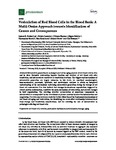Vesiculation of Red Blood Cells in the Blood Bank: A Multi-Omics Approach towards Identification of Causes and Consequences
| dc.contributor.author | Freitas Leal, JK | |
| dc.contributor.author | Lasonder, Edwin | |
| dc.contributor.author | Sharma, Vikram | |
| dc.contributor.author | Schiller, J | |
| dc.contributor.author | Fanelli, G | |
| dc.contributor.author | Rinalducci, S | |
| dc.contributor.author | Brock, R | |
| dc.contributor.author | Bosman, G | |
| dc.date.accessioned | 2020-04-11T12:31:39Z | |
| dc.date.available | 2020-04-11T12:31:39Z | |
| dc.date.issued | 2020-03-31 | |
| dc.identifier.issn | 2227-7382 | |
| dc.identifier.issn | 2227-7382 | |
| dc.identifier.uri | http://hdl.handle.net/10026.1/15555 | |
| dc.description.abstract |
<jats:p>Microvesicle generation is an integral part of the aging process of red blood cells in vivo and in vitro. Extensive vesiculation impairs function and survival of red blood cells after transfusion, and microvesicles contribute to transfusion reactions. The triggers and mechanisms of microvesicle generation are largely unknown. In this study, we combined morphological, immunochemical, proteomic, lipidomic, and metabolomic analyses to obtain an integrated understanding of the mechanisms underlying microvesicle generation during the storage of red blood cell concentrates. Our data indicate that changes in membrane organization, triggered by altered protein conformation, constitute the main mechanism of vesiculation, and precede changes in lipid organization. The resulting selective accumulation of membrane components in microvesicles is accompanied by the recruitment of plasma proteins involved in inflammation and coagulation. Our data may serve as a basis for further dissection of the fundamental mechanisms of red blood cell aging and vesiculation, for identifying the cause-effect relationship between blood bank storage and transfusion complications, and for assessing the role of microvesicles in pathologies affecting red blood cells.</jats:p> | |
| dc.format.extent | 6-6 | |
| dc.format.medium | Electronic | |
| dc.language | en | |
| dc.language.iso | en | |
| dc.publisher | MDPI AG | |
| dc.subject | aging | |
| dc.subject | lipidomics | |
| dc.subject | metabolomics | |
| dc.subject | proteomics | |
| dc.subject | red blood cell | |
| dc.subject | storage | |
| dc.subject | vesicles | |
| dc.title | Vesiculation of Red Blood Cells in the Blood Bank: A Multi-Omics Approach towards Identification of Causes and Consequences | |
| dc.type | journal-article | |
| dc.type | Journal Article | |
| plymouth.author-url | https://www.ncbi.nlm.nih.gov/pubmed/32244435 | |
| plymouth.issue | 2 | |
| plymouth.volume | 8 | |
| plymouth.publication-status | Published online | |
| plymouth.journal | Proteomes | |
| dc.identifier.doi | 10.3390/proteomes8020006 | |
| plymouth.organisational-group | /Plymouth | |
| plymouth.organisational-group | /Plymouth/Faculty of Health | |
| plymouth.organisational-group | /Plymouth/Faculty of Health/School of Biomedical Sciences | |
| plymouth.organisational-group | /Plymouth/REF 2021 Researchers by UoA | |
| plymouth.organisational-group | /Plymouth/REF 2021 Researchers by UoA/UoA01 Clinical Medicine | |
| plymouth.organisational-group | /Plymouth/REF 2021 Researchers by UoA/UoA01 Clinical Medicine/UoA01 Clinical Medicine | |
| plymouth.organisational-group | /Plymouth/Research Groups | |
| plymouth.organisational-group | /Plymouth/Research Groups/Institute of Translational and Stratified Medicine (ITSMED) | |
| plymouth.organisational-group | /Plymouth/Research Groups/Institute of Translational and Stratified Medicine (ITSMED)/CBR | |
| plymouth.organisational-group | /Plymouth/Users by role | |
| plymouth.organisational-group | /Plymouth/Users by role/Academics | |
| dc.publisher.place | Switzerland | |
| dcterms.dateAccepted | 2020-03-28 | |
| dc.rights.embargodate | 2020-6-6 | |
| dc.identifier.eissn | 2227-7382 | |
| dc.rights.embargoperiod | Not known | |
| rioxxterms.versionofrecord | 10.3390/proteomes8020006 | |
| rioxxterms.licenseref.uri | http://www.rioxx.net/licenses/all-rights-reserved | |
| rioxxterms.licenseref.startdate | 2020-03-31 | |
| rioxxterms.type | Journal Article/Review |


